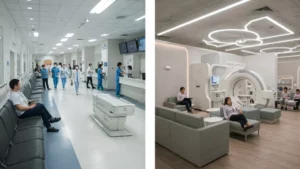One of the many illnesses that may be identified via X-rays, a form of radiology, is muscular spine discomfort. This type of test involves a beam of radiation passing through your body, producing images on film. X-rays may assist in identifying health conditions like tumors or broken fractures and diagnose other conditions like lower spine discomfort.
If you always experience lower back pains and your doctor suspects there may be structural problems in the bones or joints of your spine, an x-ray will reveal any abnormalities. That said, it’s essential to have a complete medical assessment to ensure that the cause of your back pain isn’t related to something else, such as a muscular problem, infection, or vascular disease.
You may learn how to get an x-ray for lower back pain in this article and what kind of evidence it can offer.
What Does an X-Ray Show for Lower Back Pain?
X-rays for lower back pain can show a variety of issues related to the bones and joints in the lower back. They can reveal the presence of fractures, which can result from injury or conditions like osteoporosis. X-rays can also identify arthritis, a common cause of lower back pain in older adults.
Moreover, X-rays can detect physical deviations in the vertebrae including:
- scoliosis (extreme curve of the backbone)
- spondylolisthesis (a condition in which one vertebra slips forward over the one below it).
These conditions can contribute to lower back pain by causing nerve or spinal cord pressure.
X-rays may also monitor the progression of certain conditions, such as scoliosis, over time. By comparing X-rays taken at different points, doctors can see whether the situation improves or worsens and adjust treatment accordingly.
It is important to remember, however, that X-rays are not necessarily the most accurate diagnostic method for spine discomfort. Tendon problems, such ruptured discs or nerve injury, may occasionally go undetected by X-rays. In these cases, MRI may be a more appropriate imaging test.
To choose the best diagnostics and medication strategy for your circumstance, speak with a physician.
What role does an x-ray or MRI play in diagnosing the cause of lower back pain?
Screening tools like X-rays and MRIs (Magnetic Resonance Imaging) are crucial to identify the source of lower back discomfort. X-rays can identify problems with the lower back’s cartilage and joints, such as injuries, rheumatism, or an irregular spinal curve. They can also help identify structural abnormalities contributing to the pain.
In contrast, MRI is more effective in detecting tendon abnormalities such as ruptured discs or nerve trauma. It gives surgeons more explicit pictures of the lower back’s bones, tendons, and nerves, helping them to determine what could be triggering the discomfort.
Both X-rays and MRIs have benefits and drawbacks. While rapid, affordable, and widely accessible, X-rays expose individuals to radiation. MRI, conversely, is expensive and time-consuming, but it provides more detailed and accurate images without radiation.
The decision of which radiological exam to use will rely on each patient’s specific circumstances, such as the kind and degree of their problems, their clinical background, and any other pertinent criteria. In rare circumstances, X-rays and MRI may be coupled to offer a more thorough understanding of the issue.
Difference Between X-Ray and MRI for Back Pain
X-rays and MRI (Magnetic Resonance Imaging) are two scanning procedures frequently used to diagnose back discomfort. Both can offer helpful data, but they vary significantly in what they present and how they operate.
X-ray
X-rays use a small amount of radiation to create images of the bones and joints in the back. They are quick and inexpensive, making them a common first step in diagnosing back pain. X-rays can show issues related to the spine’s structure, such as fractures, abnormal curvature, or arthritis. They can also reveal spine alignment changes, such as spondylolisthesis.
X-rays can only partially reveal the elements of soft tissues like tendons and bones. This implies that they might be unable to identify conditions like damaged vertebrae or sciatica, which are frequently linked to back discomfort. In these cases, an MRI may be necessary.
MRI
MRI is a more sophisticated scanning technique that produces finely close-up pictures of the interior components of the spine using a strong magnet and radiation waves. MRI uses no radiation, unlike X-rays, making it a healthier alternative for many people. The back’s ligaments, vertebrae, and tendons may all be seen on an MRI.
This makes MRI a valuable tool for detecting issues such as herniated discs, which can compress nerves and cause back pain. MRI can also reveal the extent of any soft tissue injuries, such as strains or sprains. Though it might not be required in every instance of back discomfort, MRI is more pricey and time-consuming than X-rays.
When Should I Get an X-Ray for Back Pain?
To diagnose back discomfort, X-rays are frequently used as a starting point. If you have suffered an accident or if your indications point to a skeletal or joint problem, such as arthritis or scoliosis, your physician might opt to request an X-ray.
Your physician may also use X-rays to track the development of specific disorders over the period. For instance, they may take regular X-rays to assess any changes in the curvature of the spine due to scoliosis. Following your doctor’s advice regarding imaging tests for lower back pain is essential.
When Should I Get an MRI for Back Pain?
If your physician suspects you are concerned with the tendons and ligaments in your vertebrae, such as a damaged disc or a torn ligament, she may recommend getting an MRI. Doctors may also need an MRI scan if you fail a urine or stool test.
An MRI can provide more detailed images of these structures than X-rays, helping to confirm or rule out specific diagnoses. If your physician needs to track the development of an injury or ailment over the period, doctors may also request an MRI.
Should I be concerned about X-ray radiation exposure?
You might ask if exposure to radioactivity should be a worry if you’re considering obtaining an X-ray for lower spine discomfort. X-rays produce pictures of the body using a little dose of radiation, which can be dangerous if a patient is subjected to it repeatedly. However, the amount of radiation exposure from a single X-ray is generally meager.
The radiation dosage from a standard X-ray is similar to the radiation a patient would generally be susceptible to over days from the surroundings. However, current X-ray technology employs methods like concentricity and filtering to reduce the quantity of radiation entering the patient’s body and immediately minimize radiation exposure.
Even so, it’s crucial to be cautious about radiation dose and to prevent needless X-rays as much as possible. This is especially crucial for some populations, like pregnant and breastfeeding women, who are more vulnerable to radiation doses and should prevent X-rays at all costs.
It’s critical to talk with your doctor if you have any worries about radiation dose or if getting an X-ray for your spine discomfort is necessary. They could help you determine if the exam is the most effective option for your specific situation by helping you assess its potential benefits and drawbacks.
Have Your Back Checked Today!
Back problems should never be taken for granted. Hence, if you have any of the aforementioned symptoms, it is advised that you see a doctor as soon as possible. Imaging tests such as X-rays and MRIs can help your doctor detect underlying issues and diagnose your back pain accurately.
At One Step Diagnostic, we offer imaging and pain management services for patients with lower back pain. Our knowledgeable staff is dedicated to assisting you in finding relief and resuming an energetic, healthier life. Book an appointment today or contact us directly with any questions. We look forward to working with you!




